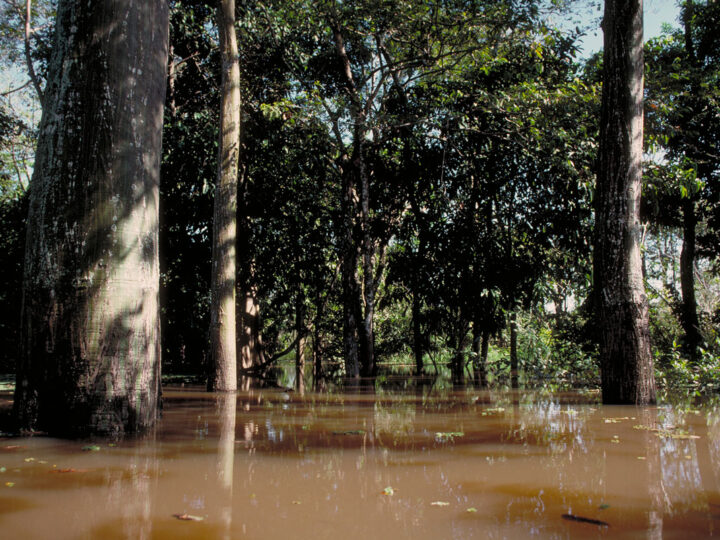
The tambaqui (Colossoma macropomum, sometimes also known as pacu or gamitana) is a tasty delight found commonly in Amazonian fish stands. Its distinctive taste is caused by its habit of skimming the surface of the river for fruit, its favorite food found in the flooded forest. It disperses the seeds of many fleshy fruits, thus contributing to regeneration of flooded forests, while on their yearly migration through the rainforest’s freshwater highways. It is also the current victim of Manaus’ “defaunation shadow.”

A defaunation shadow occurs when overexploitation of a species for urban markets results in a severe decline in wildlife abundance due to increased consumption. An international group of researchers is studying this very phenomenon with the tambaqui exploited for the Manaus market, an Amazon city with over 2.1 million people. These researchers interviewed rural fishers about their fishing efforts and tambaqui catch sizes to assess whether or not tambaqui populations were being affected by their proximity to Manaus. In short, there is a 50% reduction in both body size and catch rate of this fish, affecting fish populations over 1,000 km away from the city.
This finding has important implications. The Amazon’s population is highly urbanized and is growing. As these urban localities become more connected, there will be less unaffected space for wildlife to live in and fewer healthy fish populations that allow processes like seed dispersion promoting healthy forest growth. For example, as a tambaqui grows in size, it can disperse seeds across farther distances, allowing for greater genetic diversity within flooded forests across the basin. Given how important large tambaqui are for the rural economy, if tambaqui continue to be overexploited, this will result in a smaller average size and more limited range of movement, the rural fisher will suffer from decreased biodiversity and more limited catches– a vicious cycle.
So, what do we do?
All management of the tambaqui needs to be across river basins. Since these fish migrate all the time, authorities need to coordinate and enforce at both local and regional scales. While much of the consumption of tambaqui happens in urban areas, most of the fishing is done far away from cities by rural fishers who then transport them to these markets using styrofoam boxes filled with ice. It is important to acknowledge the temporal and spatial components of the tambaqui life in management decisions.
 However, sometimes drastic management decisions have to be made. Amazon aquatic ecologist Dr. Michael Goulding recommends a complete moratorium on tambaqui fishing in the Amazon, citing the intense threat on the species. While regulations already exist in some places, there needs to be space to continue the conversation into moratorium for the population to truly bounce back. Dr. Goulding asserts that large adults are very rare in most markets and command prices often higher than $100.
However, sometimes drastic management decisions have to be made. Amazon aquatic ecologist Dr. Michael Goulding recommends a complete moratorium on tambaqui fishing in the Amazon, citing the intense threat on the species. While regulations already exist in some places, there needs to be space to continue the conversation into moratorium for the population to truly bounce back. Dr. Goulding asserts that large adults are very rare in most markets and command prices often higher than $100.
Some critics counter the threat to extinction by promoting aquaculture with the justification that this way, it doesn’t matter what happens to the populations in the wild, tambaqui will continue being one of our resources. Currently, tambaqui aquaculture is small-scale, avoiding issues of pollution and nutrient and antibiotic runoff with larger-scale aquaculture. As long as aquaculture continues at this small-scale, it can contribute to the management of this fish by taking some pressure off the wild populations. However, farmed tambaqui do not provide a function to the larger ecosystem, such as their important seed dispersal, and thus cannot be the focus of tambaqui conservation. Additionally, consumers often prefer the taste of wild-caught to farmed fish, due to the fish’s diet. Aquaculture has played a role in other cities’ food security with different species, and with creativity, aquaculture can extend its role in wider ecosystem conservation as well. It is possible that farm-raised juveniles could be released into floodplain waters where nurseries are located to help rebuild wild tambaqui populations, but the ecological implications of this have yet been investigated by scientists.
A growing urban population has the possibility to create immense pressures on our finite natural resources, such as the tasty tambaqui. However, if scientists, citizens, policy makers, and managers work together, it can also create an opportunity for a more sustainable, and delicious future.
References
Tregidgo, D. J., et al. 2017. Rainforest metropolis casts 1,000-km defaunation shadow. PNAS 114(32): 8655-8659. DOI: https:/doi.org/10.1073/pnas.1614499114
Written by Natalia Piland.





